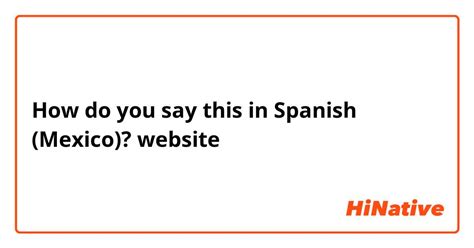El sitio web.

¡Venga! That’s how you say “website” in Spanish. But there’s more to it than just the translation. In this article, we’ll dive into the nuances of translating “website” into Spanish, exploring the variations and cultural differences that can affect your communication. So, ¡vamos a empezar!
Let’s Explore The Nuances of Website Translation!
When it comes to translating “website,” the direct translation, “el sitio web,” is widely used and understood in Spanish-speaking countries. However, there are variations that you should be aware of.
-
Sitio web is the most common term used in both formal and informal settings. It’s a general term that encompasses all types of websites.
-
Página web is another common term. It literally means “web page,” but it can also be used to refer to a website as a whole.
-
Portal web is a term used to describe a website that serves as a gateway or entry point to a larger network or collection of websites.
Variations Across Spanish-Speaking Countries
The usage of these terms can vary slightly depending on the region or country. In some countries, such as Spain, “sitio web” is the most common term. In others, like Mexico, “página web” is more frequently used. It’s a good idea to research the local preferences before using any of these terms.
Cultural Differences in Website Terminology
Beyond the linguistic differences, there are also cultural nuances to consider when translating “website” into Spanish. In English, the term “website” is often used to refer to any online presence, including social media profiles and online stores. However, in Spanish, there are more specific terms used for these different types of online entities.
-
Perfil is used to refer to a social media profile.
-
Tienda en línea is used to refer to an online store.
Common Mistakes to Avoid
When translating “website” into Spanish, it’s important to avoid some common mistakes:
-
Using “sitio web” to refer to a specific web page: Remember that “sitio web” refers to the entire website, not a specific page within it.
-
Mixing Spanish and English terms: Avoid using the English term “website” directly in Spanish. Instead, always use the appropriate Spanish translation.
-
Ignoring cultural differences: Be aware of the cultural nuances associated with website terminology in different Spanish-speaking countries.
Effective Strategies for Website Translation
To ensure accurate and effective website translation, follow these strategies:
-
Use professional translation services: Engage the services of a professional translation company or translator to ensure the highest quality of translation.
-
Provide context and instructions: Provide the translator with clear instructions and any necessary context to ensure they understand the purpose and tone of your website.
-
Review and proofread: Once the translation is complete, carefully review and proofread it to identify any errors or inconsistencies.
Table 1: Website Translation Terms
| Term | Translation | Examples |
|---|---|---|
| Sitio web | Website | El sitio web de nuestra empresa |
| Página web | Web page | La página web principal |
| Portal web | Web portal | El portal web del gobierno |
Table 2: Common Mistakes to Avoid
| Mistake | Description | Examples |
|---|---|---|
| Using “sitio web” for a specific web page | Using “sitio web” to refer to a specific page within a larger website | El sitio web de la empresa no tiene información de contacto. |
| Mixing Spanish and English terms | Using the English term “website” directly in Spanish | El sitio web de nuestra empresa es muy informativo. |
| Ignoring cultural differences | Using terms that are not commonly used in the target country | El portal web de nuestra empresa es muy completo. (Common in Spain, but not in Mexico) |
Table 3: Effective Translation Strategies
| Strategy | Description | Examples |
|---|---|---|
| Use professional translation services | Engage a professional translation company or translator to ensure the highest quality of translation. | We hired a professional translation company to translate our website into Spanish. |
| Provide context and instructions | Provide the translator with clear instructions and any necessary context to ensure they understand the purpose and tone of your website. | We provided the translator with a detailed style guide and glossary. |
| Review and proofread | Once the translation is complete, carefully review and proofread it to identify any errors or inconsistencies. | We carefully reviewed the translated website to ensure it was accurate and consistent. |
Table 4: Pros and Cons of Website Translation
| Aspect | Pros | Cons |
|---|---|---|
| Reach new audiences | Expand your audience by making your website accessible to Spanish-speakers. | Can be time-consuming and expensive if done incorrectly. |
| Improved user experience | Provide a more positive user experience for Spanish-speaking visitors. | May require ongoing maintenance to keep translations up-to-date. |
| Increased credibility | Demonstrate your commitment to serving Spanish-speaking customers by providing translated content. | Can be challenging to ensure the translation is accurate and culturally appropriate. |
